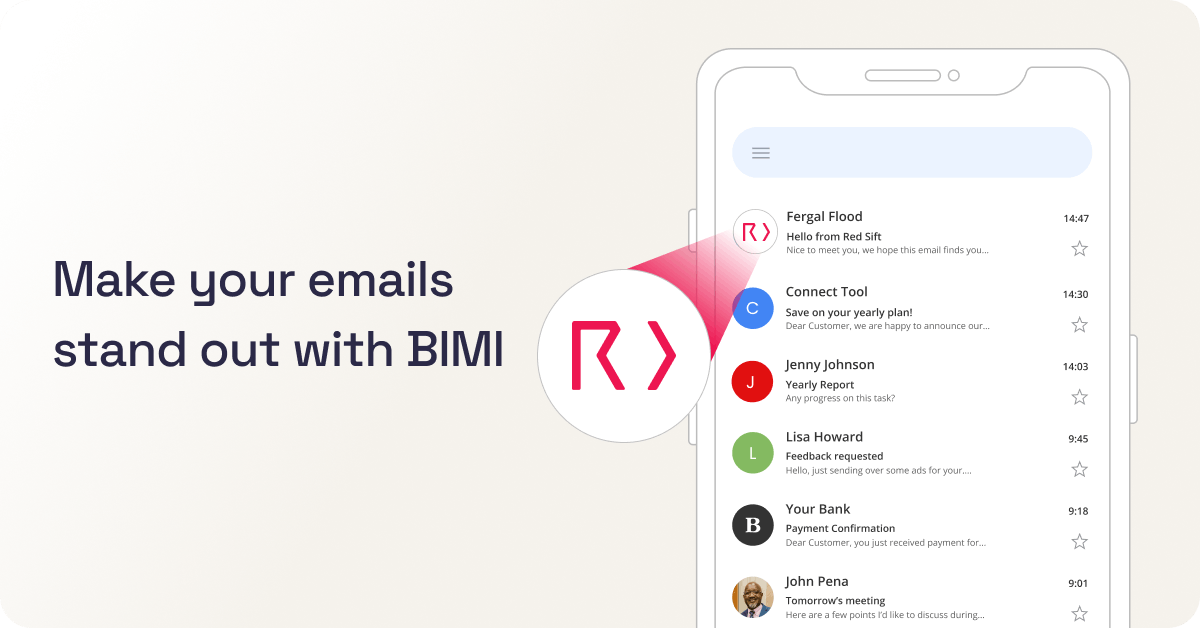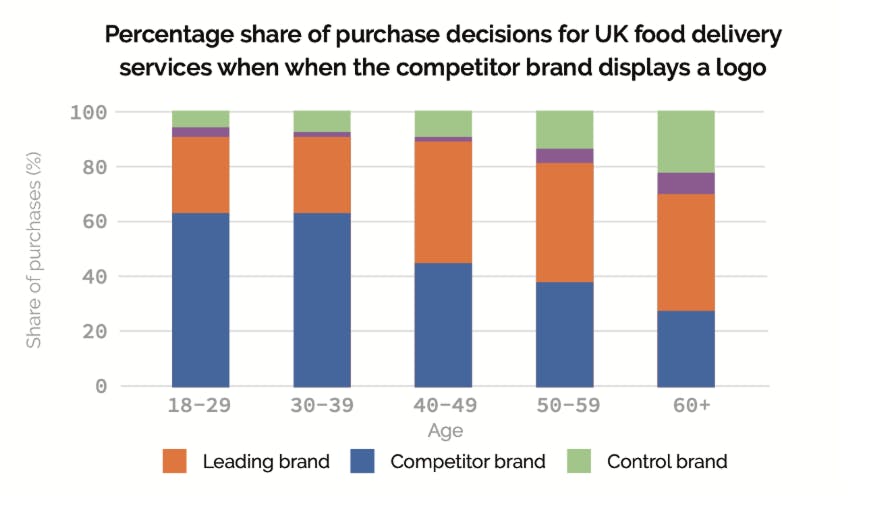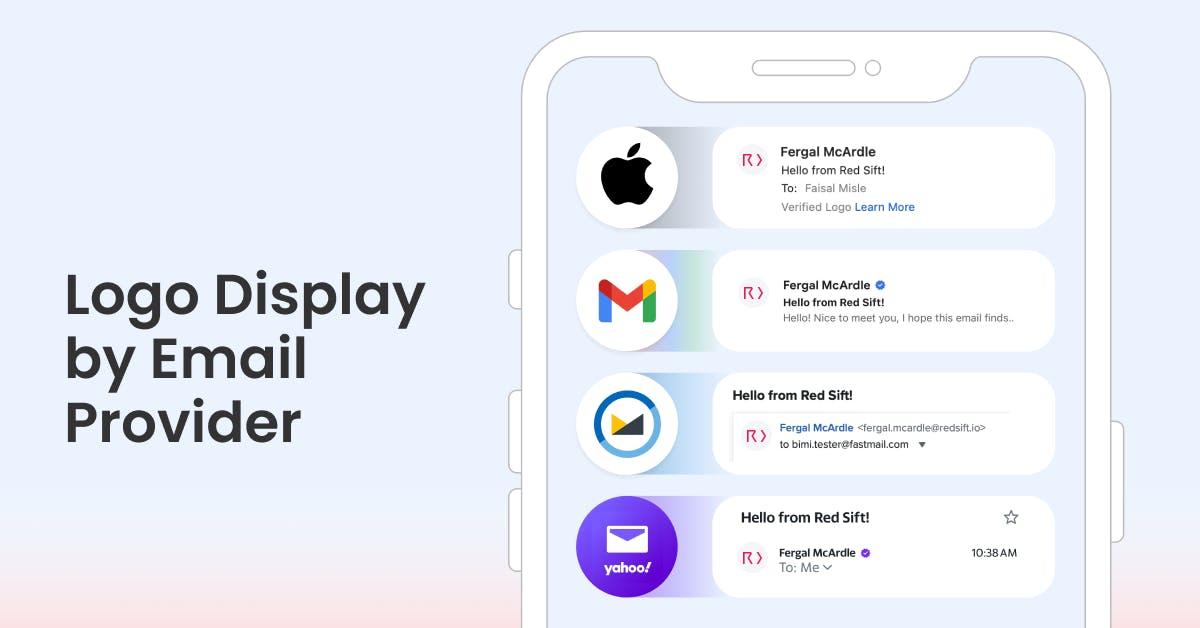Last updated: September 2025
What is BIMI?
Brand Indicators for Message Identification (BIMI) is an email standard introduced in 2021 that enables businesses to show their brand logo in the avatar slot of the Domain-based Message Authentication, Reporting and Conformance (DMARC) authenticated emails they send. This means businesses can proactively protect recipients of their email from bad actors. If you're a technical administrator, marketer, or business leader, implementing BIMI will mean you reap the benefits of better deliverability and higher open rates.
BIMI helps organizations to stand out against the noise of the inbox using either a Verified Mark Certificate (VMC) or Common Mark Certificate (CMC). In 2025, Google announced that they will adopt the use of a CMC as an assertion document, which no longer requires a trademark, providing your logo has been in use for the last year, giving organizations the option to use a CMC over a VMC. Alternatively, you can now also use an existing trademark and only use elements of it.
By adopting BIMI, businesses can showcase their brand logo directly in supportive inboxes (such as Google and Yahoo) and strengthen email authentication. Pair it with DMARC of p=reject (essential for BIMI), SPF, and DKIM, and organizations can block domain impersonation, tighten security, and boost recognition.
If you don’t already have DMARC enforcement, Red Sift makes it easy, helping organizations transition to a DMARC policy of p=reject in just 6-8 weeks, making BIMI adoption a breeze.
Not yet implemented BIMI? Check to see if your organization is BIMI ready for free.
How does BIMI work?
BIMI inserts your logo next to your email address at participating providers. It doesn’t prevent business email compromise (BEC)—that’s DMARC’s job—however, if someone tried to spoof you when you have BIMI in place, your logo won’t appear, and depending on your DMARC policy, the email may not even arrive.


Similar to SPF, DKIM, and DMARC records, your BIMI record lives in your DNS as a text (TXT) file. When an email you send arrives in the recipient inbox, the recipient server looks this record up to check that it’s coming from a verified sender (using DMARC). Once authenticated, the BIMI TXT file informs the recipient server of the logo’s location, and any relevant BIMI certificates, and it is then made visible in the recipient inbox.
Why should I implement BIMI?
Implementing BIMI can significantly increase your brand recognition and email engagement, which are crucial factors for marketing success. With BIMI, your company's logo is displayed directly in the recipient’s inbox next to your email, helping your messages stand out among the clutter. This enhanced brand visibility establishes trust and credibility with your audience, leading to higher open rates and click-through rates.
A recognizable logo can immediately evoke trust and familiarity, which is a key advantage in increasing email engagement metrics. By adopting BIMI, you create a consistent visual identity across your email communications, helping your brand gain a competitive edge.
From an email security perspective, DMARC—the protocol that powers BIMI—plays a vital role in reducing phishing attacks and email spoofing, providing better protection for your brand and recipients. Beyond its importance to email security, BIMI offers a host of other benefits for businesses, including improved brand visibility, increased trust in email legitimacy, and better brand recall. It’s even been shown to have an impact on consumer buying behavior.
Who supports BIMI in 2025?
Provider | BIMI enabled or supported? | Web vs Mobile Application differences |
Apple (iCloud Mail) | Yes — Apple Mail (iCloud) supports BIMI for senders when provider certified. | On Apple Mail (iOS/macOS) BIMI support is available (iOS 16+/macOS Ventura and higher) for Apple-hosted mailboxes. Third party providers set up in Apple Mail have to follow a set of guidelines. Only Fastmail and Cloudmark-backed mailboxes are currently compatible. |
at mail | Considering — listed as “planning/considering BIMI support. | - |
Au Mail (Japan) | Yes — introduced in 2023. | No specific public documentation found on Web vs Mobile BIMI behaviour. |
BT | Considering — BT Mail appears in lists of providers considering BIMI. | - |
Comcast | Considering — Comcast is in the planning phase to support BIMI, meaning they are actively working on implementing the standard for displaying brand logos in user inboxes. | - |
Cloudmark | Yes — Cloudmark specifically listed as supporting BIMI. | Cloudmark is a gateway that will stamp the headers — exact BIMI support depends on the mailbox provider (i.e GoDaddy). |
Docomo | Yes — NTT Docomo listed as having adopted BIMI. | Differences can depend on the type of application used, though information available is currently limited. |
Fastmail | Yes — Fastmail is an active supporter of BIMI. | Does not require a VMC. Logo will show in message list if user has avatars enabled. Otherwise it will only show up inside the message (applicable for web and mobile). Emails sent to Fastmail from a domain with a VMC will also show up in Apple Mail. |
GMX | Considering — GMX listed as “considering” BIMI. | - |
Google (Gmail) | Yes — Gmail supports BIMI (with VMC requirement). | Web: BIMI logos & blue checkmarks display. Mobile: As of Sept 2024 the Gmail Android/iOS apps support BIMI logos + checkmarks for VMC-verified brands. |
La Poste | Yes — La Poste (France) listed as a BIMI-supporting provider by the BIMI Group. | Mobile support is currently limited. |
Mail.com | Considering — Mail.com appears in lists of providers by BIMI Group. | - |
Microsoft | No — Microsoft Outlook or Microsoft 365 does not supporting BIMI. | - |
nifty | Considering — nifty appears in lists of providers by BIMI Group. | - |
Onet | Yes — Onet is listed as a BIMI-supporting provider by the BIMI Group. | Limited information is currently available. |
Qualita | Considering — is listed as considering BIMI adoption by the BIMI Group. | - |
Seznam.cz | Considering — Seznam.cz has listed BIMI as “planning/considering”. | - |
Yahoo Japan | Considering — Yahoo Japan listed as “considering” BIMI support (distinct from Yahoo Mail non-Japan). | - |
Yahoo Mail | Yes — Yahoo Mail (excluding Yahoo! Japan) supports BIMI. | Web: Shows BIMI logos in read-view. |
Benefits of BIMI
When implemented using a Mark Certificate, BIMI has many benefits for businesses of all shapes and sizes. Showing a verified logo in email using a VMC, GMC or CMC can help businesses enjoy:
- Increased brand recall by 44%
After exposure, brands that had applied a logo increased their recall by up to 44%. The stronger the brand, the higher the recall increase, up to 120%.
- Improved open rates by 39%
Open rates see up to a 39% increase in both transactional and promotional emails.
- Improved average purchase increase by 32%
The email open uplift carried over to purchasing decisions with an average buying increase of up to 32%.
- 90% increase in confidence in an email's legitimacy
Using BIMI increased consumer confidence in the legitimacy of an email by as much as 90%.
Can I implement BIMI?


Is BIMI only for IT/Security teams?
BIMI is not just designed to boost brand awareness and enhance security, but also offers an advantage for today’s marketers looking to stand out against the noise. With the average consumer receiving around 120 emails every day, making an impression in the inbox is hard. However, by putting the email fundamentals in place, you’ll put your brand in a prime position to reap the revered reward that is ROI.
Learn how BIMI can be a game changer with high ROI for your business. Hear from our VP of Marketing, Rebecca Warren.
Four Ways to Boost Email Marketing ROI in 2025
BIMI for enterprise organizations
BIMI lets you display a verified brand logo in the inbox, which improves recognition and trust at scale. It builds on your existing email authentication by requiring DMARC at enforcement and aligned SPF or DKIM, then uses a DNS record to reference a compliant SVG logo. Major mailbox providers such as Gmail and Yahoo support BIMI, which is why global enterprises in the UK, EU, and US increasingly include it in email security and brand governance programs.
Enterprise realities
Large organizations manage many domains, brands, and third party senders. That complexity makes BIMI a cross functional effort. You need a complete sender inventory, policy enforcement on core and long tail domains, and controls to keep alignment stable during change. Most providers also evaluate additional anti abuse signals, so clean authentication and low complaint rates matter for logo display.
How a modern platform helps
An enterprise grade DMARC and BIMI platform, such as Red Sift OnDMARC, streamlines this journey by discovering all senders, guiding you to policy enforcement, validating SVG and DNS records, and coordinating VMC issuance with trusted authorities. It turns raw reports into clear tasks, supports multi domain governance, and alerts you when a new sender or misconfiguration threatens logo display. This shortens time to BIMI while keeping email authentication strong across regions and business units.
BIMI for Small and Medium Businesses (SMBs)
BIMI lets your verified brand logo appear in supported inboxes, which builds trust and can lift engagement. To qualify, you need strong email authentication. That means SPF or DKIM, plus DMARC at enforcement, and a BIMI DNS record that points to a compliant SVG logo. Major providers including Gmail and Yahoo support BIMI.
SMB realities
Most SMBs use a few cloud senders for newsletters, invoices, and CRM. The typical hurdles are unclear alignment, unreadable XML reports, and uncertainty about certificates. The practical route is to authenticate properly, publish the right DNS, and keep things simple and monitored.
Partnering with a DMARC vendor
A guided DMARC and BIMI platform, for example Red Sift OnDMARC, simplifies discovery of who is sending on your domain, validates SPF, DKIM, and DMARC, checks your BIMI record and SVG, and coordinates certificate steps with trusted issuers. This reduces trial and error, shortens time to logo display, and gives you alerts when something drifts out of alignment.


Does BIMI help open rates?
In partnership with Entrust, Red Sift commissioned research into the impact of a visible logo in an email’s avatar location on open rates, brand recall, and buying behavior.
The research focused on organizations based in the UK and US. Results showed a 9% increase in transactional open rates for a leading US investment firm, compared to a 10% decrease for a competitor that didn’t make use of BIMI. Further data showed an increase in market share by 38% for a UK energy provider, up from 6% while a similar competitor without BIMI experienced an 11% drop.
What about promotional emails?
For businesses trying to sell products and services, promotional email open rates are crucial. In such a crowded market it is hard to break through against leading brands. However, when comparing a competitor’s promotional emails with BIMI implemented versus a leading brand without BIMI, US, and UK leading businesses lost 15% and 18% share of opens, while the competitors saw uplifts of 14% and 39% respectively.
In addition, Red Sift and Entrust found that overall, when a brand’s emails had a logo but a competitor’s did not, opens increased by 21% in the US and 39% in the UK. What’s perhaps most interesting is that these findings appear to be irrespective of market share or brand size.
And buyer behavior?
In both the US and UK, we compared how logo visibility impacted purchasing decisions on emails from a selection of leading and competitor food delivery service brands. In the US, businesses without a logo within their email communications experienced a 24% loss, compared with a 34% gain for competitors who did have a logo enabled.
In the UK, a leading brand lost 39% of sales share due to the lack of a visible logo, whereas a competitor with a visible logo gained an impressive 32% sales increase.


Step-by-step guide
To implement BIMI, you need to have a DMARC record in place and your organization’s sending and apex domains must be DMARC compliant (in a policy of quarantine or reject).
Organizations are required to use a Mark Certificate (MC) from an authorized Certificate Authority (CA), which works alongside an organization’s DMARC policy that is required at enforcement (either quarantine or reject) and a BIMI record.
A MC can either be a Verified Mark Certificate (VMC) with a registered trademark, a Government Mark Certificate (GMC) for government agencies, or now, the newly introduced Common Mark Certificate (CMC) for established brands.
Read our detailed guide on the key considerations before implementing BIMI.
What is DMARC?
DMARC (Domain-based Message Authentication, Reporting and Conformance) is a security protocol that protects businesses from exact domain impersonation and its harmful effects.
When correctly configured, it works using existing security protocols SPF and DKIM to tell any receiving servers that an email coming from your domain is legitimate, and stops unauthenticated and unauthorized email. This stops hackers using your domain for phishing attempts against your customers, employees and suppliers and has also been shown to improve email deliverability and placement.
What are the benefits of DMARC?
Read our definitive guide to implementing DMARC for your business
What is a Mark Certificate?
A Mark Certificate is a specialised digital certificate, issued by a trusted Certificate Authority (CA), that cryptographically links a trademarked logo to the domain authorised to send email on behalf of that brand. It serves as the “evidence document” referenced in a BIMI DNS record, allowing participating mailbox providers such as Gmail and Yahoo to display the brand’s verified logo next to authenticated messages.
Why it matters
- Brand integrity: Only legally verified logos are shown, reducing the risk of phishing campaigns that impersonate your brand.
- Higher trust and engagement: Consistent, verified branding in the inbox signals authenticity to recipients, helping lift open-rates and conversions.
- Security alignment: Mark Certificates complement DMARC, SPF and DKIM, forming a layered defence against domain spoofing and business-email compromise.
In short, a Mark Certificate provides the cryptographic proof mailbox providers need to display your brand logo safely and confidently, turning strong authentication into a visible trust signal for every email you send.
What is a Verified Mark Certificate (VMC)?
A Verified Mark Certificate (VMC) is a digital certificate issued by an authorized certification authority that enables organizations to display their registered logo next to their email messages in supported email clients. It is part of the broader Brand Indicators for Message Identification (BIMI) standard, which aims to provide visual confirmation of the email sender’s identity, thereby building trust and increasing email security.
What is a Government Mark Certificate (GMC)?
A Government Mark Certificate (GMC) is a digital certificate designed specifically for government agencies and entities to authenticate their email communications. Similar to Verified Mark Certificates (VMCs) used by commercial organizations, GMCs help government bodies establish trust and provide visual identity assurance when sending emails to the public and other stakeholders.
What are the benefits of a VMC or GMC?
- Verified brand logo in inbox: VMC and GMC enables the display of a verified brand logo in email inboxes through BIMI, making emails easily identifiable to recipients.
- Strengthened brand trust: When used with BIMI, VMC and GCMC reassures customers that the email is authentic and from a trusted source, reducing the risk of phishing.
- Higher email open rates: Displaying the verified brand logo increases the likelihood of recipients opening the email, as BIMI logos are highly visible and convey trust.
- Enhanced security: VMC or a GMC with BIMI requires DMARC enforcement, improving email security and reducing the risk of spoofing.
What is a Common Mark Certificate (CMC)?
Common Mark Certificates (CMC) are the newest MC, enabling organizations to utilize BIMI in Gmail without requiring a registered trademark like VMC or GMC. This means businesses who have established use of a known logo but haven’t gone through the registered trademark process can utilize best practices in email communications by incorporating their brand into the inbox.
What are the benefits of a CMC?
- Global recognition and accessibility: Common Mark Certificates can be recognized across Gmail’s global domains, making the BIMI mark understandable and trustworthy for a broad audience.
- Simplicity in cross-border compliance: Common Mark Certificates simplify compliance with BIMI's requirements, especially for multinational brands looking to present a consistent image in various jurisdictions.
- Improved brand perception: Displaying a logo via a CMC through BIMI promotes the brand as a standard bearer of quality, which appeals to recipients seeking consistency and reliability. Customers are more likely to interact with emails, increasing engagement and click-through rates.
- Eases international email delivery compliance: A Common Mark Certificate aids brands in meeting DMARC and BIMI requirements for international email platforms, enhancing deliverability and visibility.
Read more in our Gmail's Support for Verified Mark Certificates (VMC) in BIMI Adoption blog
Key differences between VMC and CMC
Understanding the distinctions between VMCs and CMCs is crucial for organizations considering BIMI adoption. Both certificates play a role in displaying brand logos in email clients, but they have different requirements, recognition, and use cases.
Below is a clear comparison of the main differences between VMCs and CMCs:
Feature | VMC (Verified Mark Certificate) | CMC (Certified Mark Certificate) |
Purpose | Enables BIMI logo display in email clients that support VMCs, including Google, Yahoo and Apple | Enables BIMI logo display in email clients like Google and Yahoo, but not Apple |
Trademark Requirement | Requires a registered trademark | Does not require a registered trademark. However you can alter an existing trademark, shall you only want to use elements of it. |
Issuing Authorities | Issued by specific CAs authorized for VMCs (currently only DigiCert, with more to follow) | Issued by specific CAs authorized for CMCs (currently only DigiCert, with more to follow) |
Recognition/Support | Supported by Gmail, iCloud and other providers | Currently only supported by Google |
Cost | Typically higher due to additional validation requirements | Generally lower than VMCs |
Availability | Widely available | Limited availability; relatively new and still rolling out |
Verified mark in inbox? | Yes, through email providers Apple, Google & Yahoo | Not currently |
Both VMCs and CMCs have their own benefits, choosing the right certificate for your organization doesn’t need to be complex, and Red Sift is here to help if you need further guidance. It’s important to remember that VMCs are also already widely supported, especially by Gmail, whereas CMCs are a newer option introduced in early 2025 that are yet to be adopted by other providers, such as Apple.
How do I obtain a VMC or CMC?
You can obtain a VMC or CMC with ease through a trusted certificate authority or provider such as Red Sift’s partnership with Digicert.
Can I upgrade from a CMC to a VMC?
Yes. Once your logo becomes a registered trademark, you can request a new Verified Mark Certificate. Red Sift OnDMARC workflow guides you through each step—trademark verification, CA hand-off, and DNS updates—so the transition is smooth and fully compliant.
Can I hold both a CMC and a VMC?
You may own both certificates, but only one logo can be active for a given sending domain. Publishing the CMC-based BIMI record will replace the VMC display, which removes Gmail’s blue check-mark. If you need to alternate logos, BIMI selectors are the recommended method, though mailbox-provider support is still limited. Until selectors are widely adopted, choose the certificate that delivers the inbox experience you want recipients to see.
If you want full logo display on Apple iCloud Mail, you must ensure a VMC is in place; CMC alone won’t guarantee Apple’s support under their Business Connect setup.
How do CMCs stop impersonation, given no trademark?
CMCs still build a strong barrier against look-alike senders because every certificate is issued only after a rigorous, multi-step check:
- Logo due-diligence: The CA confirms no other organisation has trademarked the logo and that your company has displayed it publicly for at least 12 months.
- Domain control & email authentication: You prove ownership of the sending domain and the CA verifies that all mail passes DMARC at enforcement, guaranteeing messages originate from your infrastructure.
- Applicant vetting: The CA validates the identity of the employee requesting the CMC and confirms they are authorised to act for your organisation.
Red Sift OnDMARC automates each of these steps, from evidence collection through to DNS updates. Gain verified inbox branding and robust anti-impersonation protection with minimal effort on your side. Start your free trial to discover the benefits today.
How VMC appears based on email provider


Desktop vs Mobile appearance
Understanding how your logo with BIMI implemented will appear on both desktop and mobile is an important step to ensuring your brand’s impact with cross-platform users.
See above our guide to how a logo display is likely to appear, note on a mobile enabled platform like the Gmail app the logo will appear in the inbox preview, on desktop the logo appears in the message preview. On Apple devices (Mail app / iCloud Mail) the brand logo appears in the avatar slot when the sender is enrolled in Apple Business Connect and the BIMI + VMC chain is satisfied. Mobile vs desktop display may vary slightly, but Apple supports logo display for verified senders via iCloud Mail.
Note: Both mobile and desktop view in Gmail only shows the verification mark enabled through a VMC in the message preview.
What about Certification Authority Authorization (CAA) in regards to a VMC?
As outlined by the bimigroup.org in their Minimum Security Requirements for Issuance of Mark Certificates document, section 3.2.15, as part of the issuance process, the CA MUST check for CAA records and follow the processing instructions found. CAs must not issue certificates unless permitted to do so by the CAA record, if one is present.
What is the purpose of a CAA record?
It allows a domain name holder to specify one or more Certification Authorities (CA's) authorized to issue certificates for that domain. CAA records allow a Certification Authority to implement additional controls to reduce the risk of unintended certificate mis-issue.
Do I need a CAA record?
The answer is it depends. CA’s are only required to check to see if there is a CAA record and if you have permitted the CA to issue a certificate for the FQDN in question.
If you do not list a CAA Record, all CA’s will be able to issue certificates for the FQDN.
Setting up a CAA record is up to you and your organization to decide if you only want a certain set of CA's to be able to issue certificates on your behalf and narrow down your exposure.
What if I want to use BIMI for more than one domain/subdomain?
By default, a VMC on the organizational domain will cascade to all subdomains. However, if you’d like to use a different trademarked logo on a subdomain, you can do so. Keep in mind this will require a separate VMC chargeable at the current rate as each VMC is tied to a specific logo.
BIMI certification requirements for VMC:
- DMARC Policy: Your domains must be DMARC-compliant, with an enforced policy (quarantine or reject).
- Trademarked Logo: The logo you wish to display must be a registered trademark.
- Certified Authority (CA): The VMC must be issued by an authorized CA, such as Entrust or DigiCert.
- BIMI TXT Record: You need to publish a BIMI TXT record in your DNS, which includes the URL to your SVG logo file.
Approved jurisdictions
Country | Source |
United States (US) | United States Patent and Trademark Office (USPTO) |
Canada (CA) | Canadian Intellectual Property Office https://www.ic.gc.ca/opic-cipo/cpd/eng/search/basic.html |
European Union (EM) | European Union Intellectual Property Office |
United Kingdom (GB) | UK Intellectual Property Office |
Germany (DE) | Deutsches Patent- und Markenamt |
Japan (JP) | Japan Trademark Office |
Australia (AU) | IP Australia |
Spain (ES) | Spain – Oficina Española de Patentes y Marcas |
South Korea (KR) | Korean Intellectual Property Office |
Brazil (BR) | Brazilian National Institute of Industrial Property |
India (IN) | Office of the Controller General of Patents, Designs & Trade Marks Department for Promotion of Industry and Internal Trade Ministry of Commerce & Industry, Government of India https://ipindia.gov.in/trade-marks.htm |
Switzerland (CH) | Swiss Federal Institute of Intellectual Property |
Denmark (DK) | Danish Patent and Trademark Office |
France (FR) | French Patent and Trademark Office (INPI) |
New Zealand (NZ) | Intellectual Property Office of New Zealand (IPONZ) |
Sweden (SE) | Swedish Intellectual Property Office (PRV) |
The verification process
- Employee verification: The CA will verify your employment with the Higher Authority and/or your HR team
- Video ID verification: Video call with a specialist that will verify your identity with a government ID
- Domain validation: Verify you own domain by entering a TXT record in your DNS zone
What are the roles within EV verification?
- Authorization contact: Provides the CA with authorization to issue VMC certificates for their organization. They will need to grant consent by email.
- Contract signer: They will accept the subscriber agreement on behalf of their organization. The agreement is online and is accepted as a click-through. This person can be the same as the Authorization Contact to simplify the process.
- Higher authority: Also known as “Independent Confirmation” – they confirm that the Authorization Contact and Contract Signer are employed with the organization and authorized to act in these roles.
How long does it take to implement BIMI?
The time it takes to deploy BIMI can vary from business to business. One of the most important steps is ensuring your domain is DMARC compliant. At Red Sift, we streamline this process through Red Sift OnDMARC, where the average time taken to get to p=reject is 6-8 weeks.
It’s worth noting that exact time will depend on the number of sources that need configuring and the speed at which you can implement the needed changes.
Additional factors include your organization’s size, the complexity of your infrastructure, and whether you are opting for a VMC or GMC. It can take anywhere from 3-6 months to get a registered logo trademark, depending on the country you’re in, versus a CMC where adoption time is expected to be shorter.
If you meet all the requirements, the actual verification process takes on average 7-10 business days. For brands targeting Apple iCloud Mail users, aligning with Apple Business Connect and submitting the brand for Apple verification may add additional time (typically an extra few weeks) beyond standard BIMI certificate issuance.
What about Apple Business Connect?
Apple has announced changes to its Business Connect function, including how a brand name or brand logo will be displayed in iPhone apps related to phone, email, and payments.
It’s true that Apple’s update resembles some similarities to BIMI, but there remain significant differences. These include the setup process, logo requirements, and cost. While Apple’s option is essentially free, the logo display is limited only to iCloud Mail.
Additionally, Apple’s Business Connect can be used in parallel with BIMI and VMC — Apple supports logo display on iCloud Mail and Apple applications like Wallet or Maps when enrolled via Business Connect (and including Gmail when used in Apple Mail), so the brand benefit extends to Apple’s ecosystem including desktop and mobile Apple Mail clients. Users will still need to reach DMARC at enforcement to implement.
Why choose Red Sift?
Red Sift OnDMARC’s BIMI feature is the only integrated BIMI with VMC or CMC solution available on the market. It helps users take care of their MC application end to end, including obtaining a VMC/CMC without having to go directly to the Certificate Authority (CA).
Red Sift OnDMARC offers seamless integration with Entrust, enabling users to easily transfer application data between the two platforms via API. This streamlined process eliminates the need for managing multiple platforms, allowing customers to achieve the necessary DMARC policy and BIMI readiness in one place. By centralizing these tasks, users benefit from a simplified experience with full guidance from industry experts, making it easier to implement both DMARC enforcement and VMC or CMC acquisition through a single interface.
Beyond BIMI implementation, Red Sift OnDMARC offers a wide variety of additional benefits including:
- Streamlined email security management: OnDMARC consolidates DMARC, SPF, DKIM, MTA-STS, and BIMI into a single platform, significantly reducing the complexity of managing email security across multiple systems.
- Close security gaps with automated protection: OnDMARC’s automated subdomain discovery ensures that every domain and subdomain sending email is protected, closing gaps that attackers could exploit. This full coverage minimizes the risk of phishing and spoofing attacks originating from unmonitored subdomains.
- Stop email security threats that bypass DMARC: OnDMARC protects against email threats that can bypass DMARC. Through continuous monitoring for misconfigurations and forgotten records in DNS, OnDMARC ensures that email authentication remains effective and that gaps attackers might exploit are closed before they become issues.
- Reduce manual tasks and time consumption with Red Sift Radar: OnDMARC’s LLM-powered assistant (Radar) cuts down on manual tasks and gives security teams immediate, actionable insights to address email security issues. Real-time alerts flag misconfigurations, authentication issues, and unusual activity right away, so teams can respond faster.
- Dedicated support for fast DMARC implementation: The Red Sift team provides dedicated, hands-on 24/7 support throughout the setup and implementation process for OnDMARC. From initial configuration to ongoing adjustments, the team helps streamline the adoption of DMARC, SPF, DKIM, and MTA-STS, ensuring organizations achieve strong email security without delays or misconfigurations.
Validate your logo with OnDMARC
Red Sift OnDMARC offers validation that your logo is using the correct BIMI format, even prior to submitting an application.
- Click on “start application” within the BIMI section of Red Sift OnDMARC dashboard
- Drag and drop or browse for your logo and OnDMARC will provide a validation. If your logo meets the criteria you will see confirmation of this on the screen, any errors with the logo will also be highlighted.
Ready to get started?







